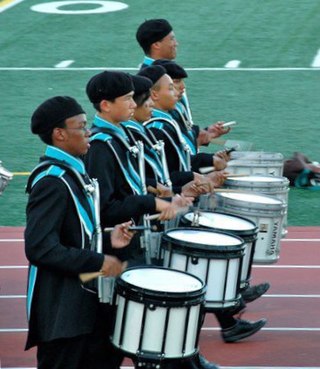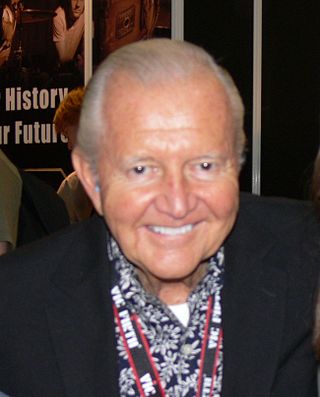Related Research Articles

A drum kit is a collection of drums, cymbals, and other auxiliary percussion instruments set up to be played by one person. The player (drummer) typically holds a pair of matching drumsticks, one in each hand, and uses their feet to operate a foot-controlled hi-hat and bass drum pedal.

A percussion instrument is a musical instrument that is sounded by being struck or scraped by a beater including attached or enclosed beaters or rattles struck, scraped or rubbed by hand or struck against another similar instrument. Excluding zoomusicological instruments and the human voice, the percussion family is believed to include the oldest musical instruments. In spite of being a very common term to designate instruments, and to relate them to their players, the percussionists, percussion is not a systematic classificatory category of instruments, as described by the scientific field of organology. It is shown below that percussion instruments may belong to the organological classes of ideophone, membranophone, aerophone and cordophone.

The snare is a percussion instrument that produces a sharp staccato sound when the head is struck with a drum stick, due to the use of a series of stiff wires held under tension against the lower skin. Snare drums are often used in orchestras, concert bands, marching bands, parades, drumlines, drum corps, and more. It is one of the central pieces in a drum set, a collection of percussion instruments designed to be played by a seated drummer and used in many genres of music.
A blast beat is a type of drum beat that originated in hardcore punk and grindcore, and is often associated with certain styles of extreme metal, namely black metal and death metal, and occasionally in metalcore. In Adam MacGregor's definition, "the blast-beat generally comprises a repeated, sixteenth-note figure played at a very fast tempo, and divided uniformly among the bass drum, snare, and ride, crash, or hi-hat cymbal." Blast beats have been described by PopMatters contributor Whitney Strub as, "maniacal percussive explosions, less about rhythm per se than sheer sonic violence".
"The 'original' or traditional blastbeat is a single-stroke roll played between your cymbal and snare, with your kick playing simultaneously with every cymbal hit."
Glyn Thomas Johns is an English musician, recording engineer and record producer.

Daniel Edwin Carey is an American musician and songwriter. He is the drummer for the American rock band Tool. He has also contributed to albums by artists such as Zaum, Green Jellö, Pigface, Skinny Puppy, Adrian Belew, Carole King, Collide, Meat Puppets, Lusk, and the Melvins.

Snare technique is the technique used to play a snare drum.

Bernard "Buddy" Rich was an American jazz drummer, songwriter, conductor, and bandleader. He is considered one of the most influential drummers of all time.

A drum roll is a technique used by percussionists to produce a sustained sound for the duration of a written note.
All drum figures are based upon three fundamental beats, technically called roll, single stroke, and flam...Sustentation is accomplished upon wind instruments by blowing into the instrument; it is accomplished upon the violin and the allied instruments by drawing the bow across the string; it is accomplished upon the drum and allied percussion instruments by the roll.
THE SNARE DRUM ROLL.
The roll consists of an even reiteration of beats sufficiently rapid to prohibit rhythmic analysis. To produce an impression of sustentation, these beats must be absolutely even both in power and in sequence. Uneven beats in a roll destroy the impression of sustentation. Evenness is then the primary quality to strive for in roll; speed is the secondary quality to strive for.
There are two possible ways of producing an absolutely even sequence: (1) hand alternation of single stroke and (2) hand alternation of double strokes...The snare drum roll is produced by hand alternation of double strokes.
The "open roll" is produced by [initially] slow hand alternation. Two strokes in each hand alternately are produced by wrist movement and each beat should follow its predecessor in clock-like precision.

Marching percussion instruments are instruments specially designed to be played while moving. This is achieved by attaching the drum(s) to a special harness worn by the drummer, although not all marching bands use such harnesses and instead use traditional baldrics to sling their drums.

In rudimental drumming, a form of percussion music, a drum rudiment is one of a number of relatively small patterns which form the foundation for more extended and complex drumming patterns. The term "drum rudiment" is most closely associated with various forms of field drumming, where the snare drum plays a prominent role. In this context "rudiment" means not only "basic", but also fundamental. This tradition of drumming originates in military drumming and it is a central component of martial music.
A tenor drum is a membranophone without a snare. There are several types of tenor drums.
The Casey Claw is a rudimental snare drum technique that is used as an impressive visual effect for a very short phrase of music. It is not intended to be used as a regular drumming technique, and it has mainly been used in drum and bugle corps. The technique gives the impression that one stick is spinning very quickly while at the same time a rapid succession of notes is being played on the drum. It was originally developed by Mark Casey in 1993, a former marching member and drum sergeant of The Cavaliers of Rosemont, Illinois.
Orchestral percussion refers to the various percussion instruments used in an orchestral setting. It may also refer to the act of playing such instruments in an orchestral style. Many music schools and conservatories offer training for musicians interested in developing their skills as an orchestral percussionist. Typically, an orchestral percussionist does not specialize in one particular instrument. Although there is no exhaustive list of all instruments that an orchestral percussionist must be able to play, there are particular instruments that are frequently used in orchestral repertoire. This includes timpani, snare drum, bass drum, xylophone, glockenspiel, triangle, and tambourine.
The Moeller method, Moeller technique or whipping technique is a percussive stroke method that combines a variety of techniques with the goal of improving hand speed, power, and control while offering the flexibility to add accented notes at will.
Noble & Cooley is an American musical instruments manufacturing company based out of Granville, Massachusetts. Having been established in 1854, it is the oldest drum company in the United States and is one of the oldest in the world. Having manufactured toy drums at the beginning, Noble & Cooley soon entered the professional drum market.
Sanford Augustus Moeller (1878–1960) was an American rudimental drummer, national champion, educator, and author. He was born in Albany, New York on February 16, 1878, and he began his music education by studying the piano.

Everett Joseph "Vic" Firth was an American musician and the founder of Vic Firth Company, a company that makes percussion sticks and mallets.

In percussion, grip refers to the manner in which the player holds the percussion mallet or mallets, whether drum sticks or other mallets.
Charles "Charley" Wilcoxon was an American drum teacher and drum method book writer. He wrote several influential books on rudimental drumming that are still used by drum teachers today. He is a member of the Percussive Arts Society Hall of Fame.
References
- ↑ Mirsky, Ellis (December 28, 2008). "Backsticking - A Drumming Technique Institutionalized by John Dowlan". Field Drums. Retrieved November 20, 2016.
- ↑ Mirsky, Ellis (January 3, 2009). "Was Carrington Backsticking in the 1870s? YES!". Field Drums. Retrieved November 20, 2016.